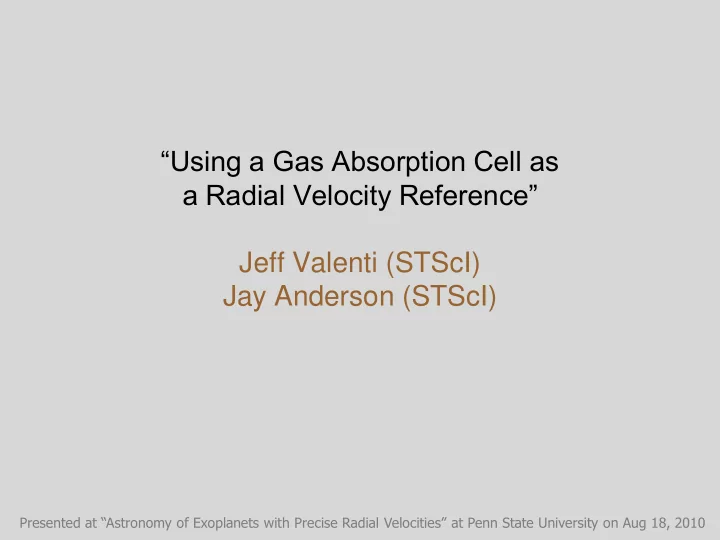

“Using a Gas Absorption Cell as a Radial Velocity Reference” Jeff Valenti (STScI) Jay Anderson (STScI) Presented at “Astronomy of Exoplanets with Precise Radial Velocities” at Penn State University on Aug 18, 2010
Why a gas cell can be useful… A gas cell imprints on each spectrum the behavior of optics and detector for the actual illumination conditions during that observation Compensate for spectrograph instabilities. Data analysis is nontrivial. Planets still lurking in 15 years of existing data from slit spectrographs.
Outline Modeling observations Intrinsic stellar spectrum Iodine cell temperature Line spread function Residuals Results
Using a Gas Absorption Cell Model calculation Determine wavelength scale of observation Shift intrinsic stellar spectrum by stellar radial velocity Multiply by gas cell transmission spectrum Convolve with local line spread function Determine normalization function to match observation Free parameters for each observation Wavelength scale Stellar radial velocity Normalization function Line spread function
Wavelengths from Iodine Cell Absorption Lines
Velocity Shift of Intrinsic Stellar Sepctrum
Line Spread Function of Spectrograph
Constructed Model of Observation
Outline Modeling observations Intrinsic stellar spectrum Iodine cell temperature Line spread function Residuals Results
Three Ways to Determine the Intrinsic Spectrum Observe directly with R ~ 300 000 spectrograph Deconvolve using contemporaneous LSF Observe B stars with iodine to get an LSF Observe target star without iodine Deconvolve to get intrinsic stellar spectrum Assumes LSF is stable between observations Deconvolve using simultaneous LSF Observe target star several/many times with iodine “Grand solution” gives LSF and intrinsic stellar spectrum Still working to understand and tune the algorithm
Deconvolution using Contemporaneous LSF
Plenty of Constraints for Grand Solution New Code
Stellar Spectrum Rings if Nodes Too Far Apart Code Same Set of Reduced Spectra New Completely New Analysis Code
Stellar Spectra Deconvolved Two Different Ways
Outline Modeling observations Intrinsic stellar spectrum Iodine cell temperature Line spread function Residuals Results
Transmission Spectrum of Keck Iodine Cell FTS spectra at three iodine cell temperatures 50, 55, and 60 C Interpolate to other temperatures as needed
Temperature Sensitivity of Iodine Lines
Iodine Cell Temperature vs. TEMPIOD1 Temperature variation, but velocities are good
Environment Can Affect Gas Cell Temperature Thermal Control Radiative Cooling Calibration Mirror T IN In T IOD2 T IOD1 Second Sensor Stabilized Sensor Control Sensor Second Sensor Out Environment
Outline Modeling observations Intrinsic stellar spectrum Iodine cell temperature Line spread function Residuals Results
LSF Changes For Each Exposure Consecutive exposures 67 second cadence Raw LSF shift 0.0039 pixels 5.2 m/s After modeling I 2 0.5 m/s Factor of 10 better
LSF Variations for Consecutive Exposures Spectrograph is stable on short time scales Slit illumination may vary Misguiding Seeing changes Pupil illumination may vary Misguiding with telescope out of focus Particular concern for mosaic gratings Reduce effects with spectrograph design Fiber feed Precise guiding
Spline Nodes Describe Narrow LSF Core Fixed Centroid at Zero Free New Code
Works Equally Well for Broader LSF Core New Code
Broad LSF Wings Seen in Laser Exposures 6328.16 Å 5939.32 Å 5433.65 Å 1.3% of LSF is outside ± 7 pixels
Outline Modeling observations Intrinsic stellar spectrum Iodine cell temperature Line spread function Residuals Results
Fit Residuals for B Star Spectra New Code
Fit Residuals for 992 B Star Spectra New Code
Adjusted Fit Residuals for 992 B Stars Systematics reduced but not yet eliminated New Code
σ Dra without Residual Correction Prior to Reducing Fit Residuals New Code
σ Dra with Residual Correction and Uniform BC Systematics reduced but not yet eliminated After Reducing Fit Residuals New Code
Outline Modeling observations Intrinsic stellar spectrum Iodine cell temperature Line spread function Residuals Results
Radial Velocities for τ Cet New Code
Radial Velocities for HD 9407 New Code
Radial Velocities for HD 156668 New Code
Radial Velocities for GJ 412a 1 pixel per node in intrinsic spectrum New Code
Main Points Gas cell compensates for spectrograph instabilities Need Instrinsic stellar spectrum Obtain directly with R ~ 300 000 spectrograph Deconvolve using contemporaneous LSF Deconvolve using simultaneous LSF (“grand solution”) Iodine cell temperature depends on environment Describe LSF by spline curve Centroid at zero breaks degeneracy with wavelengths Need to accommodate extended wings seen in laser Diagnostics of systematic errors Fit residuals of many stars in iodine reference frame Radial velocity versus barycentric correction Grand solution is starting to yield precise velocities
Recommend
More recommend